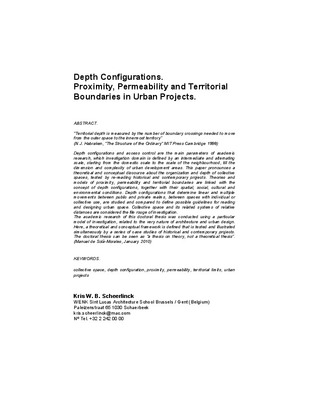JavaScript is disabled for your browser. Some features of this site may not work without it.
Buscar en RiuNet
Listar
Mi cuenta
Estadísticas
Ayuda RiuNet
Admin. UPV
Depth Configurations. Proximity, Permeability and Territorial Boundaries in Urban Projects
Mostrar el registro completo del ítem
Scheerlinck, KWB. (2012). Depth Configurations. Proximity, Permeability and Territorial Boundaries in Urban Projects. http://hdl.handle.net/10251/15036
Por favor, use este identificador para citar o enlazar este ítem: http://hdl.handle.net/10251/15036
Ficheros en el ítem
Metadatos del ítem
| Título: | Depth Configurations. Proximity, Permeability and Territorial Boundaries in Urban Projects | |
| Otro titulo: |
|
|
| Autor: | Scheerlinck, Kris W. B. | |
| Fecha difusión: |
|
|
| Resumen: |
"Territorial depth is measured by the number of boundary crossings needed to move from the outer space to the innermost territory"
(N.J. Habraken, "The Structure of the Ordinary" MIT Press Cambridge 1998)
Depth configurations ...[+]
|
|
| Palabras clave: |
|
|
| Derechos de uso: | Reserva de todos los derechos | |
| ISBN: |
|
|
| Fuente: |
|
|
| Editorial: |
|
|
| Título del congreso: |
|
|
| Lugar del congreso: |
|
|
| Fecha congreso: |
|
|
| Descripción: |
|
|
| Tipo: |
|






